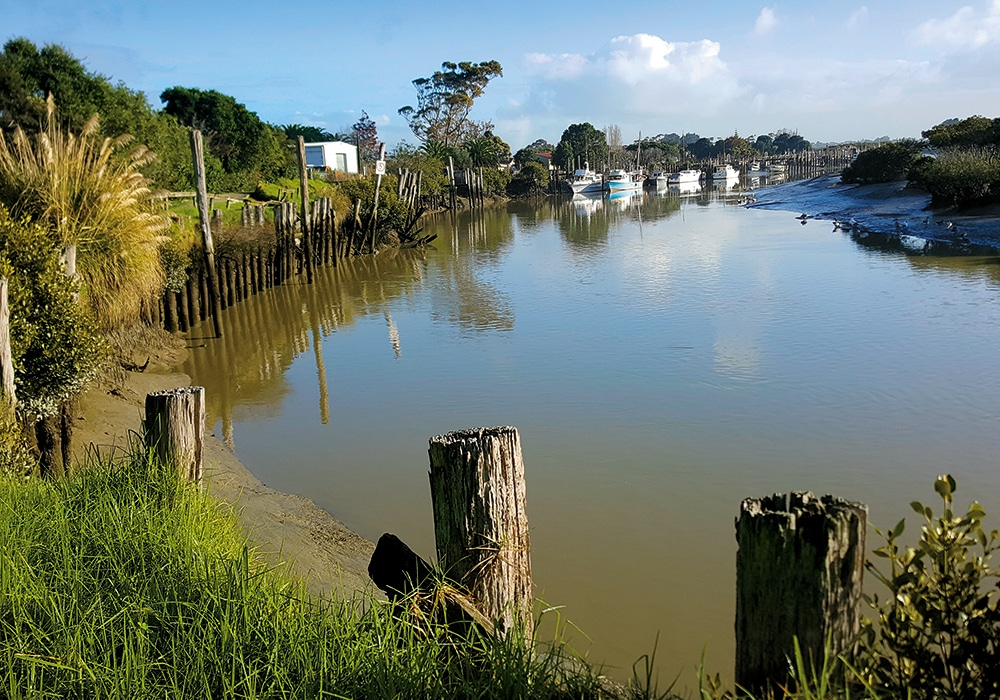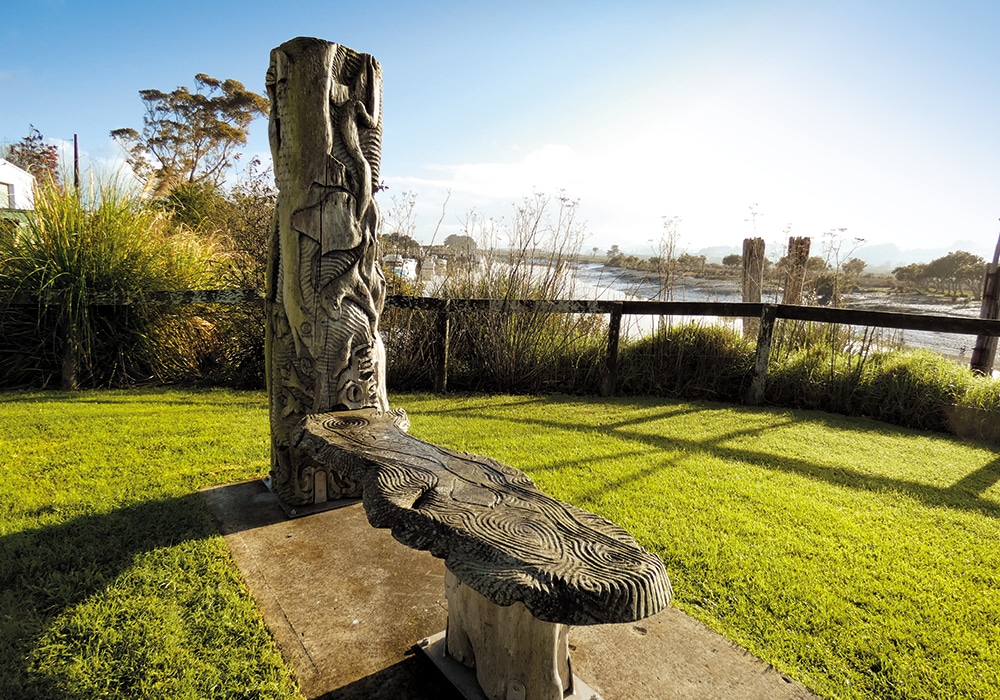Heather Whelan investigates some peaceful spots that border the Kawau Parua Inlet.
Kawau Parua Inlet is almost enclosed by headlands that jut into the Kaipara Harbour – Oyster Point to the east and Shelly Beach to the west. Helensville sits at its southerly end, at the entrance to the Kaipara River.
Historic Helensville
Māori had long lived on the shores of the Kaipara when the first Europeans settled there. John McLeod came to mill timber in 1862, and built a kauri villa as his family home. He named it Helen’s Villa, and the name stuck for the whole settlement of Helensville.
The area had previously been known as Te Awaroa, ‘the valley of the long river’. The Kaipara River played a vital part in Helensville’s early development, as did the railway, which opened in 1875. The timber industry boomed in the 19th century, when kauri spas were transported by ship from Helensville. It wasn’t until the 1940s, when a road was built over the Brynderwyn Hill, that river and harbour routes north from Auckland declined in importance.

Helensville’s fortunes have gone up and down over the years, but it is a pleasant place to stop and wander around. We discovered the riverside walkway, which begins at Mill Road and took us along boardwalks and paved paths to the high point of Commercial Road, beside the old Post Office. As well as giving us views of the river and a cluster of boats, the path led through plantings of native trees and shrubs: a peaceful change from the busy main street.
We turned left on Commercial Road and wandered down to the old Railway Station, home to the Ginger Crunch Cafe, which is always worth a visit. The station was built in 1880; before this, passengers and goods had to travel by sea from Onehunga, or make their way overland from Riverhead.
Railway buffs will be interested in the 1881 steam locomotive that stands beside the railway station. On loan from MOTAT, it is almost identical to the D class engine that brought the first train to Helensville. The Helensville Railway Museum is housed in a new building beside the locomotive, but only opens on Sundays, so we’ll have to check that out another time.


Te Korowai-o-Te-Tonga
The South Kaipara Peninsula, renamed Te Korowai-o-Te-Tonga in 2013, extends 35km from Helensville to the mouth of the Kaipara Harbour. The name means ‘the cloak of the south’, and reflects the protective role of the peninsula in sheltering the harbour from westerly winds. We turned north and drove through Parakai, famous for its hot pools. We had booked overnight parking there, but wanted to explore further up the peninsula first.
Our first stop was MacNut Cafe, tucked off the road in a macadamia orchard. The cafe has pretty views over the orchard and lakes; visitors can take self guided tours, but we just took in the view, along with the coffee and macadamia-themed treats.
Further along the road we took the turn for Shelly Beach. Originally known as Aotea, the beach was named for the canoe, Aotea, brought into the Kaipara for repairs that were carried out at this spot. Later, Aotea was the venue for a meeting of local Māori who were debating whether to join the King movement (they didn’t). A meeting house was constructed and a copy of the Treaty of Waitangi was kept under glass, surmounted by an image of Queen Victoria. Later a hall and church were built, but all these buildings were eventually moved to another part of the harbour. A pyramid monument on the shore commemorates this history.

The stretch of Shelly Beach near the monument was actually sandy, but at the other side of a long wharf and a recently installed groyne we came to the shells. We walked along the beach, before taking a track up to the cliff-tops and then down through pōhutukawa to a carpark beside the wharf. At the end of the carpark we discovered an area for motorhome parking with powered sites.
This campground is administered by the folk at The Jetty cafe, which looks out over the beach, wharf and harbour. We couldn’t resist buying lunch here and enjoying the picturesque view.
Fishermen were busy launching boats, and casting their lines from the end of the 100 metre-long wharf. Locals advise taking care at the end of the wharf, especially in windy weather, as it has no handrails. Next time we’ll stay at Shelly Beach and also venture further north, as there are a regional park and lakes to explore at the end of the peninsula.

Hot pools and hot chips
We were keen to have a soak in Parakai’s hot pools, so returned to the little town and parked in the campground area next to Parakai Springs. The campground is now run by Auckland Council, and you have to pre-book to get the code for the gates. The kitchen and ablution blocks have been removed, so it is only suitable for self-contained vehicles. However, the location is picturesque as it is part of Kaipātiki Reserve, a grassy area with many mature trees.
People have been enjoying Parakai’s thermal water since 1881, when the first muddy ‘pool’ was dug. By the early 1900s the pools had been developed and there were hotels to cater for visitors. We spent the next hour at Parakai Springs, a big complex with a hydroslide, indoor and outdoor pools, and private spas. It was off-season so we practically had the place to ourselves. There’s another pool complex, Palm Springs, across the road. This has recently been upgraded and is lovely to visit on fine days (the pools are all outdoor).
Feeling relaxed after our soak, and too lazy to cook dinner, we wandered along to the Four Square, which has a hot food counter at one end with a variety of takeaway options. We got hot chips to go with the chicken and salad we had in the fridge in our bus. The other dinner options in Parakai are a Chinese restaurant and a pizza place.

Plants and sculpture
Heading north on SH16, through Helensville and past the village of Kaukapakapa (which sticks to the watery theme as its name means ‘swim with much splashing’), we soon came to a sign for the Kaipara Coast Plant Centre and Sculpture Gardens. At the end of a driveway there’s a cafe and the entrance to 3.5km of garden, sculpture and forest trails.
David Bayly has run the plant centre since 1988, and he has developed the property to display over 40 sculptures, sited along the trails. The sculptures are changed every year, so it’s worth visiting regularly. We had coffee and cake at the cafe before strolling around the gardens and admiring the artworks, which ranged from tiny to huge. It takes about an hour and a half to complete the circuit. There’s a new track opening soon – the Harbour View Track – and, looking at the map, I think visitors will be able to look across the Kawau Parua Inlet to Shelly Beach on the far shore.


More Information
- For more on the places mentioned, visit: helensvillerail.org.nz; parakaisprings.co.nz; palmspringsparakai.co.nz; macnut.co.nz; kaiparacoastplantcentre.com
- You can book motorhome camping at Parakai at: aucklandcouncil.govt.nz. Go to the section ‘Book accommodation at our parks’.
- To arrange parking at Shelly Beach, contact the Facebook page of The Jetty cafe, Shelly Beach or phone 09 420 2595.






